Welcome to the Revenue Era 👋
In this new era, digital is no longer just a channel. It’s your entire brand experience.
But how did we get here?
Enter stage left, 2020.
A year that consolidated a decades-worth of experiences and mayhem into 365 days.
On average, the global pandemic sped up digital transformation for B2B businesses by six years.
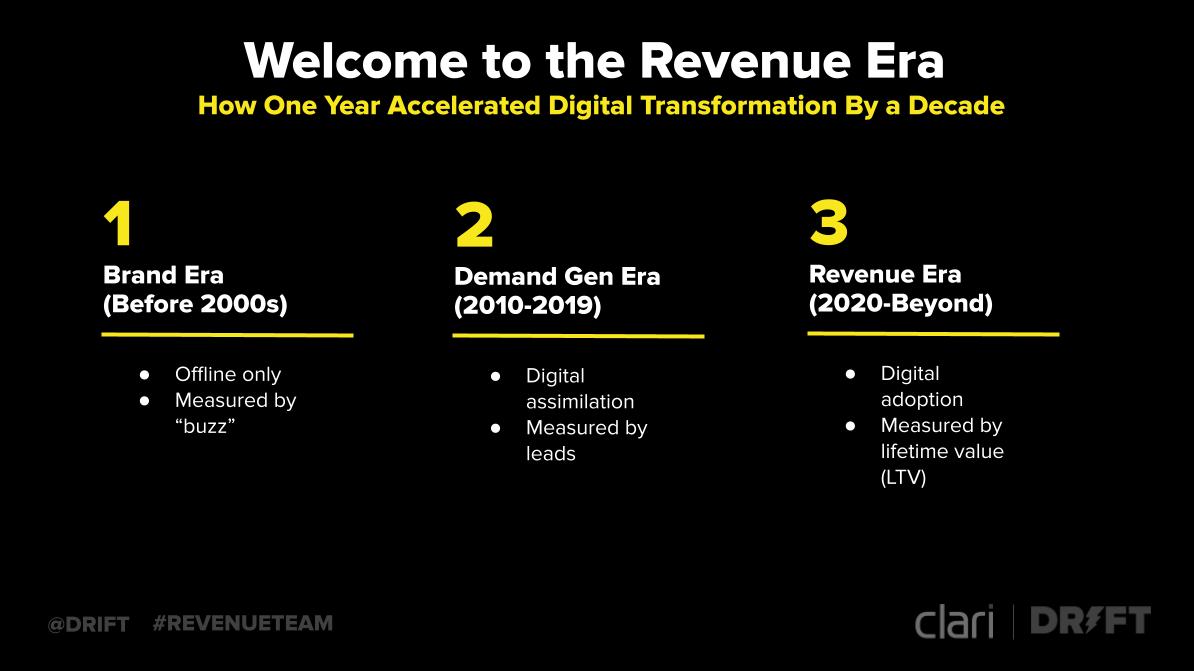
When companies sent employees home, we all needed to adapt. We embraced new ways of communicating and new go-to-market (GTM) processes. We remembered that empathy is the gold standard of B2B marketing and sales. And we got closer to our customers and buyers than ever before.
We can no longer think of marketing, sales, and customer success as separate, siloed teams. Together, they are one single revenue team – hyper-focused on helping customers find success in this new normal.
I recently chatted with Clari’s VP of Revenue Growth and Enablement, Kyle Coleman, about this shift, and how revenue teams can help accelerate revenue in uncertain times.
If you want to watch our presentation, click here. Otherwise, keep reading for all the insights 💡
Organizational Friction Is Killing Your Bottom Line
Marketing and sales teams define success differently.
So no wonder they don’t always get along.
But the buyer’s journey is completely different in this new era. They’re coming to you through different channels, armed with research, reviews, and information. That means you have to be always ready, no matter if it’s your SDR picking up the phone, your social media manager replying to a comment, or your customer service rep helping solve an issue via a support ticket or your sales team answering a quick question via chat.
You need to optimize digital experiences in many different places to get ahead.
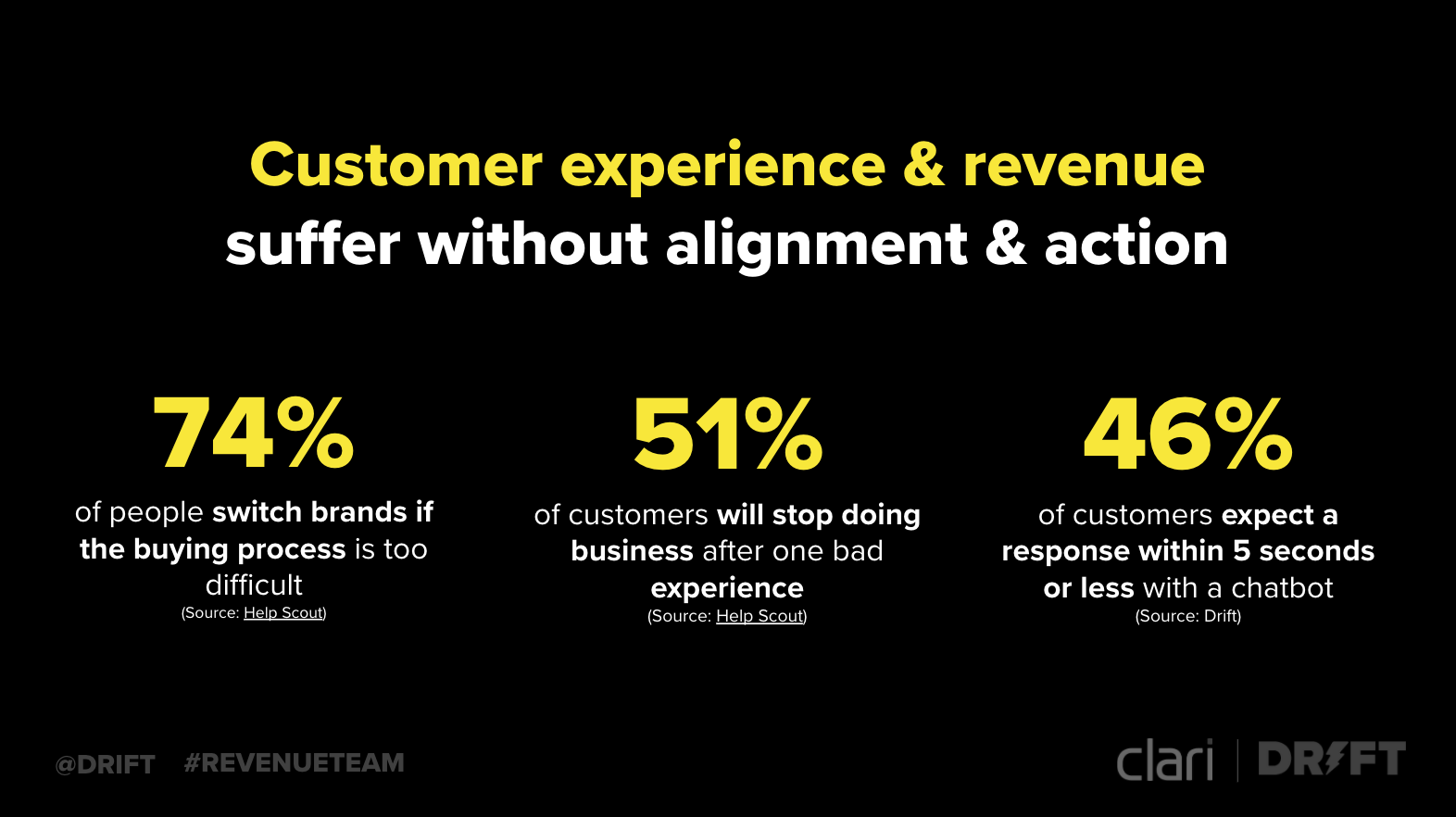
It comes down to your customer experience.
74% of people will switch brands if the buying process is too difficult. But we measured marketing on leads, and so marketing went and got leads rather than focusing on a great customer experience. Forms became the norm.
I’m looking for a new car right now, and honestly, I’m so frustrated.
I’ve filled out forms asking for a ridiculous level of information (it feels like it’s not a stretch that they’d ask for my child’s middle name), which I’ve dutifully filled out. If I have time to fill this form out, why hasn’t anyone called me? Because they’re still evaluating whether I’m worth their time.
That experience sucks. And guess what? It’s probably how your customers feel, too.
51% of customers will stop doing business after one bad experience. So let’s talk about the post-sales side of things, too. Have you ever been on hold for an hour trying to ask a question to customer support? If I’m a paying customer, why can’t I get answers?
Your customers have higher expectations, and you need to meet them – or you’ll lose them. In Drift’s 2020 State of Conversational Marketing report, we found:
- 46% of customers expect a response within five seconds or less using a chatbot
- 14% of customers expect an immediate response from your web forms (up 45% from 2019)
- 10% of customers expect an immediate response to an email to support (up 33% from 2019)
Who’s responsible for customer experience? Everyone. But especially the three parts of a revenue team; sales, marketing, and customer support. And there’s one measurement that unites each group: the pursuit of revenue.
So why doesn’t the entire revenue team have a shared revenue goal?
Companies with aligned revenue teams have 15% higher profitability and 19% faster revenue growth.
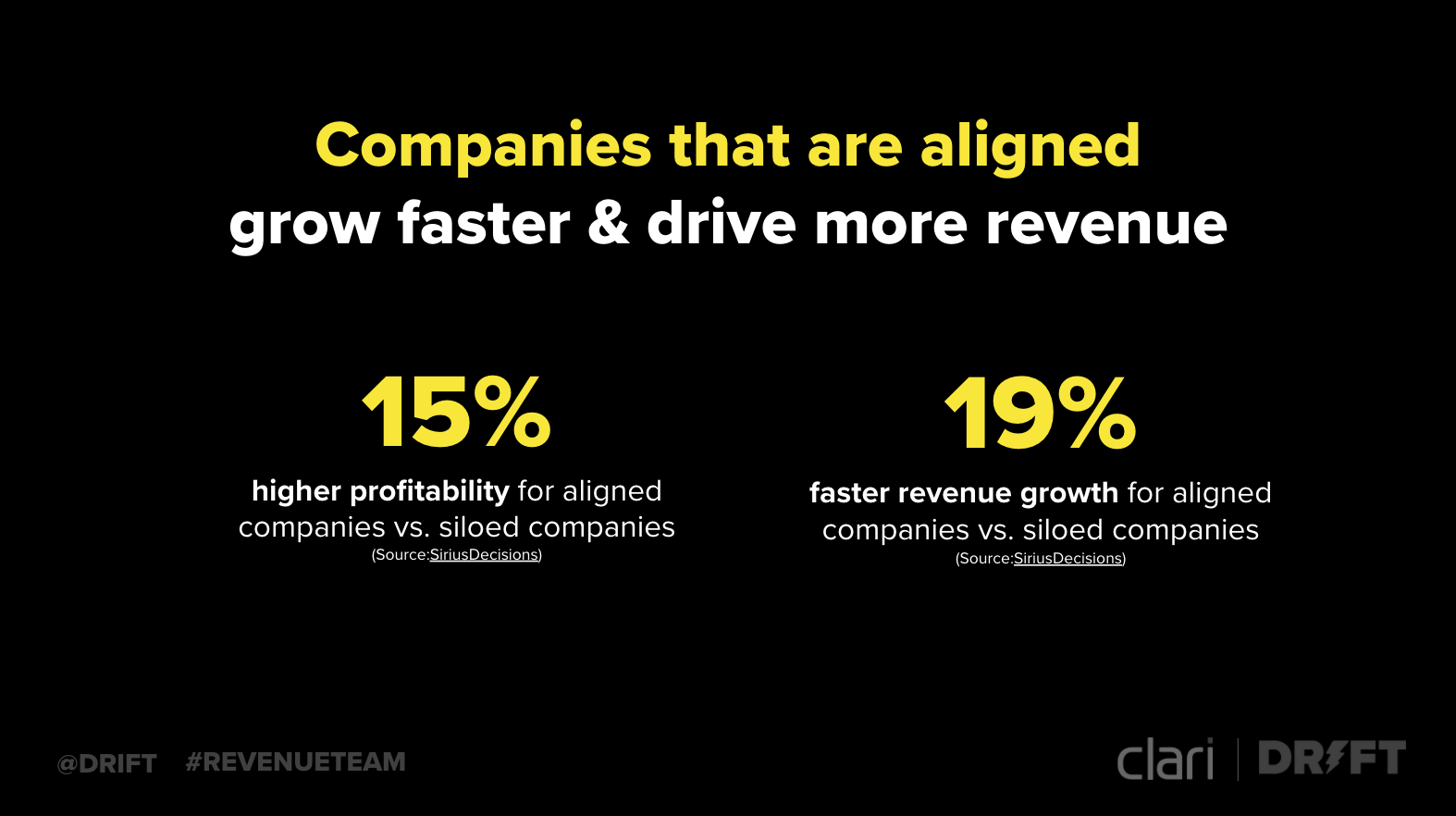
This means delivering a streamlined experience that meets buyers on their terms and drives last value across the board.
We’re way past “sales and marketing alignment.”
Yes, you still need to align. But on a deeper level, you also need to:
- Bring sales and marketing together
- Connect revenue teams to the buyer
- Communicate with buyers in real-time
You need to take action as one revenue team, together. You need revenue acceleration.
What Team? Revenue Ops
Forget sales ops, marketing ops, and CS ops. It should be one team: revenue operations.
Revenue operations is the means by which revenue teams think about their entire sales process, breaking it down into its component parts to find ways to optimize every part of the funnel. This creates mutual accountability between revenue teams and allows for consistent, reliable execution…and predictable revenue.
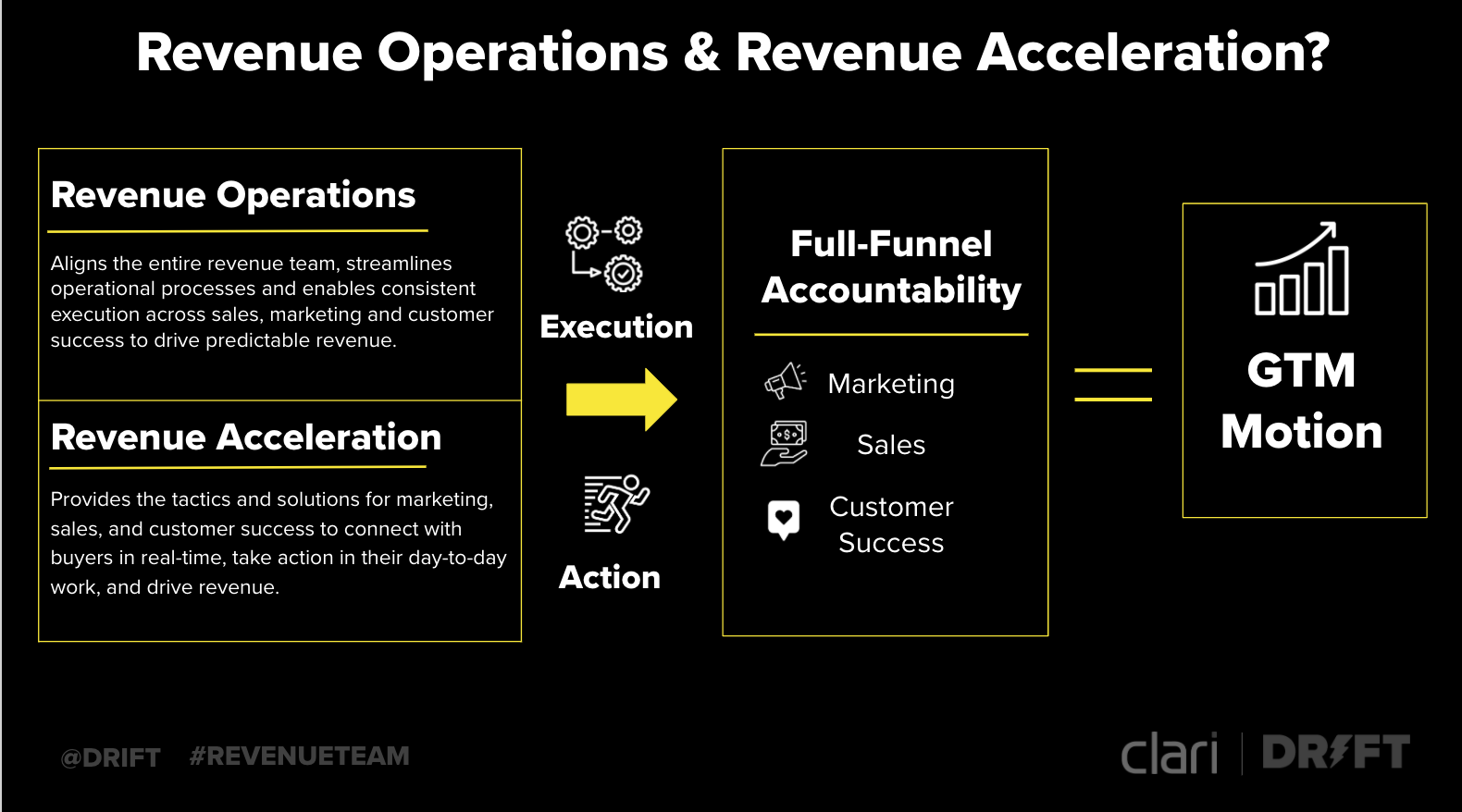
Revenue operations is what makes revenue acceleration possible. These are the tactics and solutions for marketing, sales, and customer success to connect with buyers in real-time, take action in their day-to-day work, and drive revenue. When you combine revenue ops and revenue acceleration, you get…
Full-Funnel Accountability + The Framework for Revenue Teams
We’ve all been on teams that just throw things over the fence and hope they’ll make it. It’s easy to say, “Well, my job’s done. It’s your problem now.”
Customers don’t see the fences between revenue teams. They just see one company. Your customers expect that you understand them. They expect that you’re paying attention at every part of the process.
To have a strong GTM motion with a revenue team, you need strong handoffs and mutual accountability. The revenue framework looks like this:
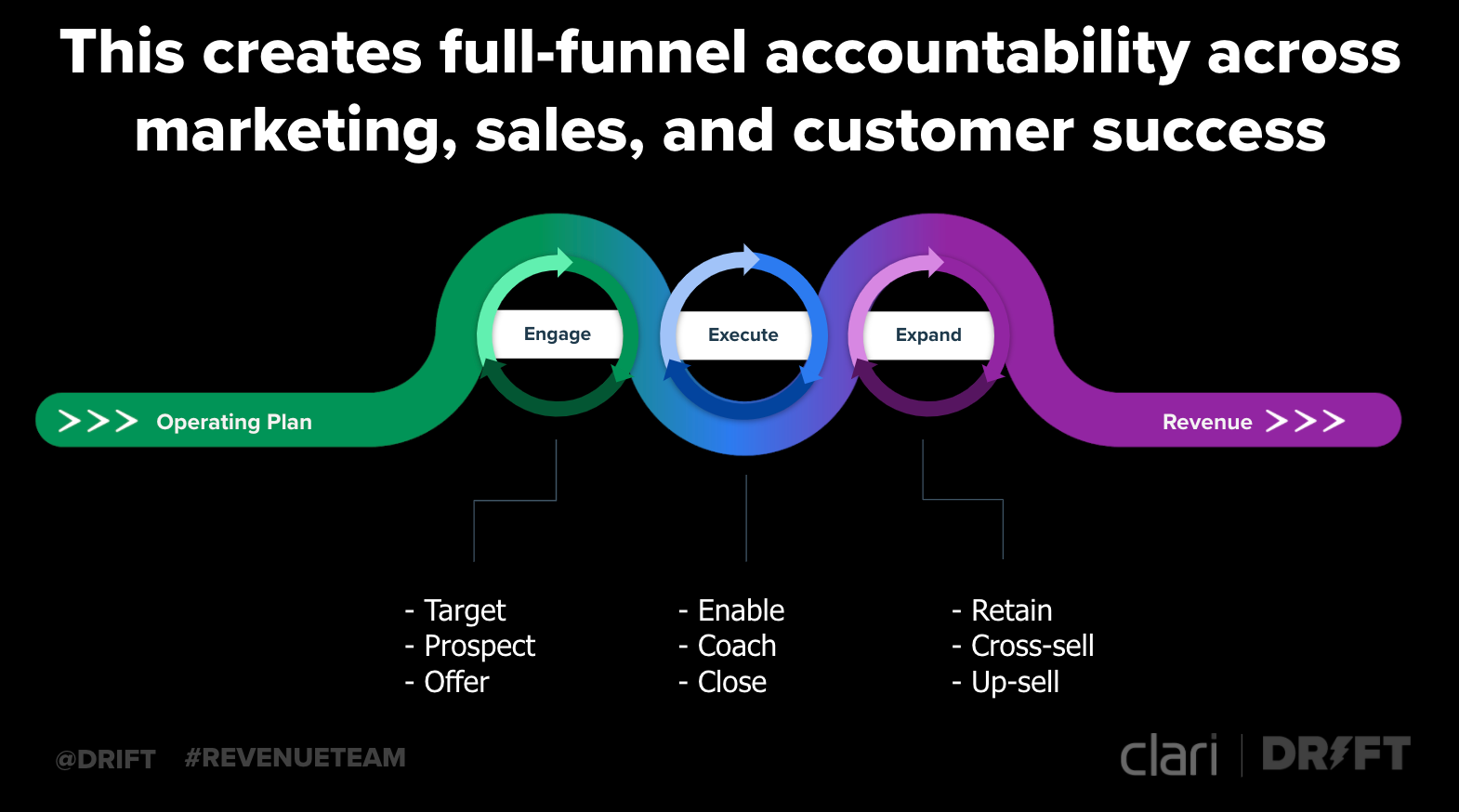
Full funnel accountability.
What do I mean by that? It’s making sure you’re getting a clear handoff.
- Operating Plan: It starts with an operating plan. What do you need to make happen this year? How much revenue do you need to close? Calculate up the funnel to understand how much pipeline you need to create.
- Engage: That brings you to the engage phase. This is where the top of funnel marketing teams do their thing, targeting, prospecting, and creating offers to build a high-quality pipeline.
- Execute: This is where the deals get closed, with sales teams creating net new revenue and customers.
- Expand: Retention, renewal, and upsells of those new customers.
This all feeds back into the operating plan to start the process over again. It’s not just about revenue, but about accurately forecasting these different stages. That’s how you build predictability.
5 Steps to Accelerate Revenue Teams
Once you have a plan to engage, execute, and expand, you need to take action. Follow these five steps to accelerate your revenue:
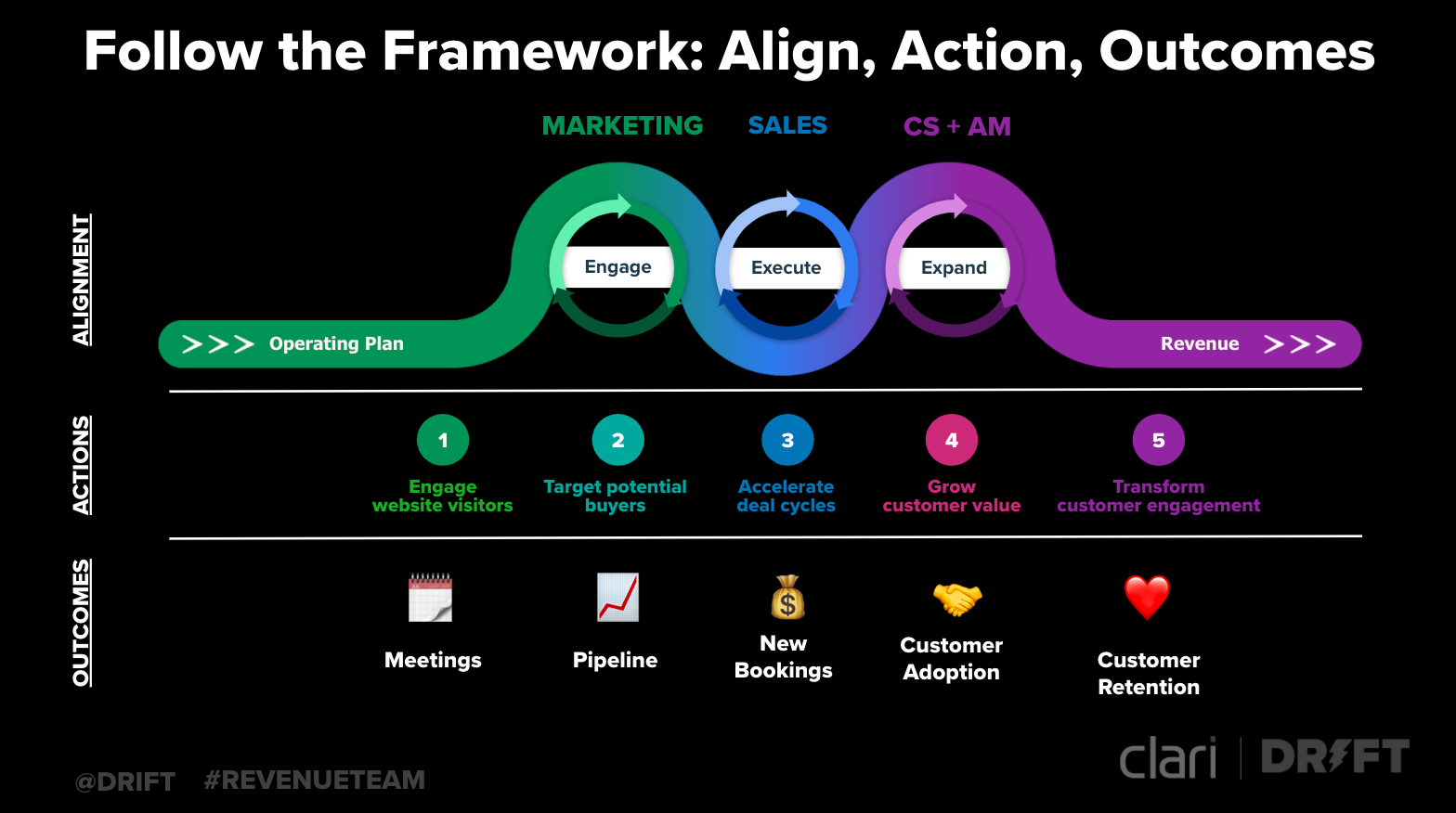
1. Engage Website Visitors
Start with the reverse waterfall, working backward from revenue to conversion rate, leads, and traffic. How are you going to identify and engage website visitors?
The first place they’re on your turf is your website. But with an average of 2% conversion rate, that can feel like you’re pushing a rock up a hill, spinning up ad campaigns, social media, and SEO strategies. You’ll generate all that traffic, but you’ll still only get 2% of those people to convert.
The answer is freeing yourself from the form.
Chatbots can do so much more than a form can – from asking qualifying questions, setting up conversations, offering specific pieces of content, or connecting them directly with a rep right that second.
Of the 2% of people converting on your website today, it’s near impossible to tell until later who has come to your site. What if you could get them right now? You can roll out the red carpet to the accounts that matter, answer any questions they have, and make sure they get the real-time website personalization they’re expecting.
2. Target Potential Buyers
Let’s face it. You don’t look at a pricing page of a website unless you’re serious. If you’re going to start with one page on your site to optimize, make it that one.
To do this, you need to know who is landing on your website. Once you know (hey, we have a tool for that!), you can build out and refine a list of target accounts, geographies, or industries that match with the people sales wants to talk to.
Because no one wants to do a ton of work generating traffic and leads only to have the sales team say, “Wow, that was a waste of my time.”
Qualitative information is just as important as quantitative. Sales needs to know if they’ve gone through a chat experience, what blog posts they’ve read, where they’ve visited on the site, and any other intent signals you can share. The more they know, the more tailored their conversations can be in the execute phase.
This is the time to show your prospects how much you care about them. And the best way to do that is a seamless transition between your revenue teams so the sales team has everything they need to close the deal.
3. Accelerate Deal Cycles
Once the handoff is complete, the sales team closes the deal.
That’s easy to say but much more challenging to do. Cool tactics like video and swag aside, so much goes into each conversation, especially as deals get more complex.
The key here is spotting risk. Sales reps need to understand what the risk signals are in their deals, spot them proactively, and take action on them by:
- Creating objection handling messaging
- Building playbooks around specific risk factors
- Noting common scenarios and build processes around them
Then, we move on to post-sales.
4. Grow Customer Value
Just like the qualitative handoff is important between marketing and sales, it’s also important between sales and customer success or account management. Again, everyone in your revenue team needs to understand what’s going on for the account, what problems the customer is solving with your product, and what value you’re bringing to the table.
That way, when issues come up (and they will), your team is ready to guide your customers so they can realize the full value…and you can earn expanded business with them.
So many of us have been on calls with account reps assigned to you that don’t seem to know anything about what your business does or what you’re struggling with. How is that supposed to make you feel good about having just signed on the dotted line?
5. Transform Customer Engagement
Retention is earned.
You can’t just hope that an automatic credit card payment will slip through the cracks.
You need to show your customers that you really care about them. Real customer-centricity – not the buzzword, but the practice – means continuously educating your customer and engaging with them so you can help them realize their goals.
Their success is your success.
All of this leads to a repeatable process that’s built with both your revenue team and your customers in mind. That means transforming customer engagement from a quarter-by-quarter basis to a long-term plan that prioritizes revenue. Following these steps gives your teams the clarity they need to add value and work together.
No more throwing things over the fence.









